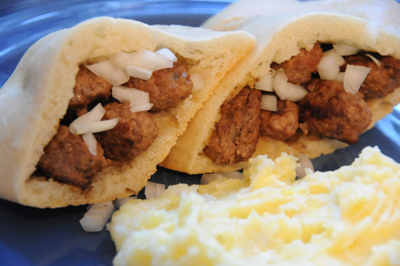 |
| Bosnia and Herzegovina: Cevapi on Lepinje with Kacamak. |
Specifically, this week we are in Bosnia Herzegovina, which is one of those countries that everyone has heard of, but for all the wrong reasons. I first became aware of Bosnia Herzegovina back in the 90s, when the news from that region was filled horror—ethnic cleansing and massacres followed by a NATO bombing campaign, all of which combined to kill somewhere in the order of 110,000 people, with 1.8 million displaced from their homes. Those are actually pretty astonishing figures when you consider that today Bosnia Herzegovina is a nation of just 4 1/2 million people.
| Here's Bosnia, in Eastern Europe. |
Fortunately the dust settled in 1995 with the signing of a peace agreement, and today Bosnia Herzegovina is pretty quiet, with a thriving tourism industry (ranked third highest in growth compared to the rest of the world) and one of the world's highest "income equality rankings" (8th out of 193 nations), which means that if you live in Bosnia Herzegovina you're probably more or less in the same financial boat as everyone else who lives in Bosnia Herzegovina.
Now the good news for me this week is that the Internet is full of resources for recipes and cuisine from Bosnia Herzegovina. The bad news is, almost all of those resources are written in Croatian. Which is fine, if you have Google Translator and an extra 10 to 12 hours you can spend translating, sifting through, interpreting and selecting your menu. I, however, am a mother of four. So for my main course, I went with the one and only English recipe I could find: cevapi.
Now if you don't know about that secret cache of Croatian language recipes from Bosnia Herzegovina, you might think that cevapi is the only thing they eat there. This is because pretty much everyone in any English speaking country who ever wanted to try making Bosnian food has done cevapi. I found the recipe in at least a dozen different places before I stopped trying. It sounded good though, so I only had a mild inkling to find something else, and this stemming from the fact that Bosnian cevapi isn't really a main dish. It's a snack, which is usually sold as fast food by street vendors.
Anyway, here's the recipe (this version came from Visit Bosnia Herzegovina):
Cevapi
- 1 tbsp lard or butter
- 1/2 yellow onion, finely chopped
- 1 garlic clove, finely chopped
- 1 lb lean lamb
- 1 lb lean beef
- 1 egg white, lightly beaten
- 1 tbsp sweet paprika
- 2 tbsp onions, finely chopped
Cevapi are usually served in pita bread, called Lepinje. Fortunately I didn't have to look too far to find a recipe--the original version was in that cache of Croatian language recipes (on a site called coolinarika.com), but was kindly translated for us by bloggers Kemal and Sheila.
Because sometimes translated and traditional sources leave out important details (like amounts), this recipe required some trial and error. Here's the version I ended up with:
Lepinje
- About 2 1/2 cups bread flour*
- 2 1/2 tsp active dry yeast
- 1 1/2 tsp salt
- 1 tsp sugar
- 1 cup water
- Olive oil for brushing
* I said "about" because I started with two cups (the original author of this recipe doesn't give amounts for flour or water) and added small handfuls as my bread machine was working until it looked like it was about the right consistency.
For a side dish:
Kacamak with Potatoes and Cheese
- 3 cups water
- 2 medium to large potatoes, peeled, cubed and boiled
- Salt to taste
- 1 1/4 cup yellow corn meal
- 1/2 cup feta cheese
- 1/4 cup oil
And finally, for dessert:
Socni Kolac
- 4 eggs
- 3/4 cup cooking oil
- 1/4 cup walnuts, chopped
- 1/4 cup raisins
- 1/4 cup grated coconut
- 1 level tsp baking powder
- 1/2 cup granulated sugar
- 1 2/3 cup water
- 1 cup heavy cream
- 1 tsp vanilla extract
- 1 tbsp confectioners' sugar
By the way, that is not a typo—there is no flour in this recipe.
The first recipe I did this week was the cevapi, though in retrospect it should have been the lepinje, since my dinner ended up being late while I waited for the lepinje to rise and bake. So let's start there, that way you don't have to make the same mistakes I did.
Now as you know, I never make any bread recipe unless I can adapt it for my bread machine, because kneading is for chumps. Fortunately, pretty much every bread recipe can be adapted for a bread machine, but this one was a little more challenging since I didn't know exactly how much flour to use. So as usual, I just dumped all the ingredients (starting with just two cups of flour) into my machine and turned it on. As the paddle was working the dough, I added the extra half a cup or so since the dough was way too wet. Then I just let the cycle complete.
If you don't have a bread machine, you would do it this way:
First prove the yeast with the sugar and about 1/2 cup of lukewarm water. Meanwhile, mix the dry ingredients in a large bowl.
When the yeast is foamy, pour it into the flour with another 1 to 1 1/2 cups of water. Mix well. Your dough should be a little bit sticky, but not ridiculously so.
Turn out onto a floured surface and knead for five minutes. Shape into a ball and place in a large bowl greased with olive oil. Cover with plastic wrap and a towel, and let rise in a warm place for an hour or so, or until doubled in size. (I took mine out of the bread machine to let it rise).
Put the dough back on the floured surface and punch down. Knead again for another minute, then divide into four balls. Brush with olive oil and let rest for 10 or 15 minutes.
Roll the dough balls with a floured rolling pin until they are roughly the thickness of extra-thick pizza crust.
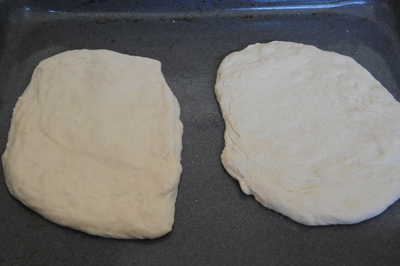 |
| I've decided to spare you from the boring dough pictures, so this is the only one I'm posting. |
Transfer them to a greased baking sheet and brush with a bit more olive oil. Cover with plastic wrap and a towel and let rest for another half hour or so.
Meanwhile, preheat your oven to 400 degrees. When the dough has rested remove the towel and plastic and put the pitas in the oven. Bake for 10 minutes, then reduce the heat to 350 degrees and bake for another 5-10 minutes.
The recipe says to flip the pitas halfway through cooking, but I didn't bother. They were delicious just as they were.
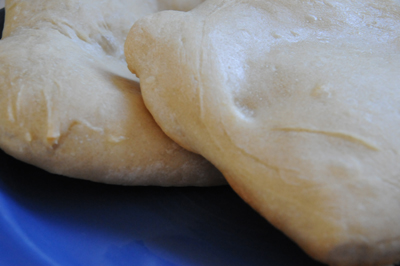 |
| To serve with the cevapi, cut each pita down the middle and make a pocket with a sharp knife. |
Now on to the cevapi, which are simple and only a little time consuming.
First melt the lard or butter over medium heat. Add the onions and sauté until translucent. During the last three minutes or so, add the garlic and keep stirring to prevent burning.
Remove the onions and let cool.
Mix the ground lamb with the ground beef (I had to grind both with my meat grinder). Add the onion/garlic mixture, egg white and paprika and mix well.
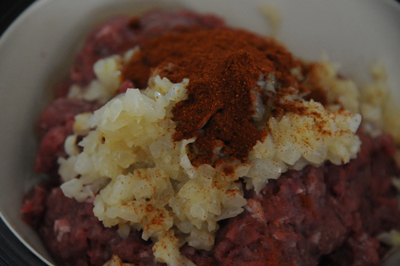 |
| The cevapi ingredients are pretty simple. |
Now shape the meat into unappetizing looking little cylinders, which are the traditional shape. Cover with plastic wrap and refrigerate for at least one hour.
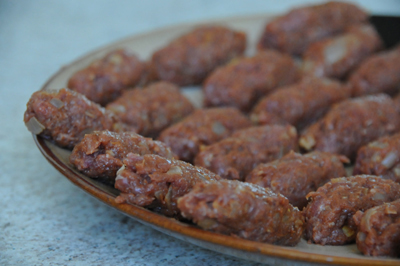 |
| Hmm, yeah, those look ... um ... good? |
Pan fry the cevapi in a little olive oil until nicely browned.
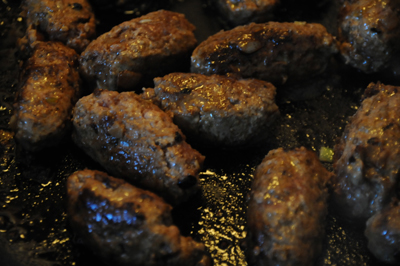 |
| The cevapi are finished when they are nicely browned on all sides. |
To serve, cut your pita breads in half and make a pocket in each one. Stuff a few finely chopped onions inside the pita, then add the cevapi and top with a few more of the onions.
Now on to the kacamak:
First you'll need to boil your cubed potatoes as you would when making mashed potatoes (I did mine for about 10 minutes). Then drain and bring a second pot of water to a boil (I used two cups of water, but my kacamak was way too thick so I've estimated the correct amount to be probably closer to three cups). Add the potatoes and salt and cook until the potatoes start to break apart. Now without draining the water, gently mash up the potatoes. Slowly add the cornmeal, continuing to stir. The texture should be like cream of wheat. Don't let it get too thick (you may not need all the cornmeal the recipe calls for). When it's done cooking you can add a little oil (I didn't bother).
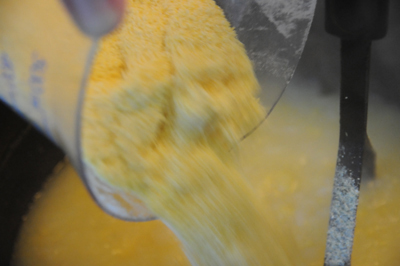 |
| Add the cornmeal and keep stirring until the mixture is about as thick as cream of wheat. |
Now remove from the heat and add the cheese, stirring until mostly melted. Serve hot.
And finally, the socni kolac, which in Croatian means "rich cake."
The socni kolac was weird. First of all, it contained no flour, which by itself isn't that strange (I've made flourless chocolate cakes before) except that the whole body of the cake was made mostly of eggs. I had to go back and check the original recipe to make sure I hadn't miscopied it, because that seemed really odd. Sure enough, the original recipe did not call for flour. Neither did any of the Croatian language versions I tracked down. So I just decided to have blind faith.
Here's how it's done:
First preheat your oven to 400 degrees. Beat the eggs and mix the with the oil, walnuts, raisins and coconut. Add the baking powder. Pour the mixture into a lightly oiled pan (it should be thin, maybe about a half inch).
 |
| This is the batter. The very eggy batter. |
Put the pan in the oven and bake until the edges are starting to brown. Now, the recipe said this would take 5 to 10 minutes. In my oven it took more like 20 minutes, and when I took it out the center was still jiggly and the whole thing smelled like an omelet. At this point I didn't have much hope left, but I carried on.
While the cake is baking, melt the sugar in the water and simmer until it starts to become syrupy. When you remove the cake from the oven, pour the syrup over it while it is still hot. All of the syrup.
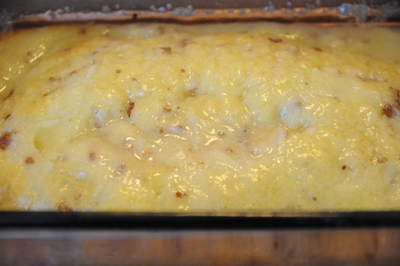 |
| Here's what it looked like after 20 minutes in the oven. Like an undercooked omelet. |
If you have the same experience as me, it will seem like way too much syrup, and the whole thing will start to collapse and the jiggly center will start to look like a very mushy jiggly center, and you'll think "Oh God what have I done." Now turn the oven off and put the cake back inside to cool. After about 30 to 45 minutes you'll take it out and be amazed by how perfect this near disaster now appears. Refrigerate for an hour or two.
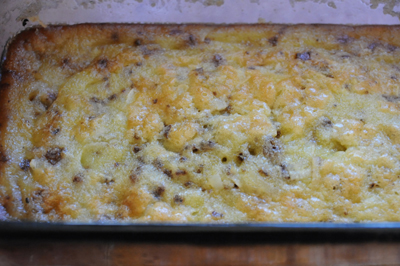 |
| After cooling, this actually looks like it might be OK. |
Put the whipping cream in your mixing bowl and whip until stiff peaks form, then add the confectioner's sugar and the vanilla. Whip a little more to blend. Take the cake out of the fridge and gently spread the whipped cream on top. Serve cold.
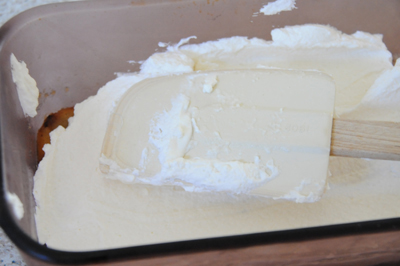 |
| Top with the whipped cream. Done! |
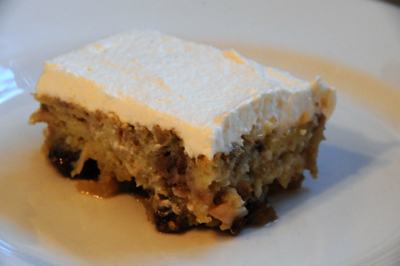 |
| This actually turned out pretty good. |
My family's reaction was amusing. I'll start with the best part.
I decided to spare my long-suffering children the indignity of having to eat onions, so I stuffed the pitas with the cevapi and added a side of kacamak to each plate. Natalie (who just turned four) came running to the table, sat down and looked at her food for a long time.
"Why is it poo?" she finally said.
Yes, the cevapi is unfortunately shaped. But I convinced her to eat it, and she finished at least half of her meal though the kacamak wasn't her favorite part. Hailey ate one cevapi and some of her pita, then sat at the table staring at the kacamak, having what appeared to be random mild seizures while making the same noise that a wounded wildebeest might make if it was hoping to attract a pride of lions to put it out of its misery. Eventually I got her to eat three bites of it, but it was quite dramatic. The boys ate everything on their plates.
As for the dessert, Hailey scraped the whipped cream off of hers and ate that. So did Natalie. Henry ate most of his. Dylan finished off everything that everyone else didn't eat.
As for Martin and me, we thought the cevapi would have been nicer served with some sauce—and evidently it is served with sauce (as I found out later) in other parts of Eastern Europe, where it goes by various different names. It is sometimes eaten with sour cream, cottage cheese or other types of fresh cheeses, and sometimes with traditionally prepared condiments. Though this recipe made no mention of any accompaniment other than onions, if I made cevapi again I would certainly add something to liven it up.
I liked the kacamak too, though it was really stodgy. It was really just a nice, different twist on a mashed potato.
The cake was surprisingly yummy for something that seemed to be catapulting towards disaster. I was able taste the eggs over all that syrup, nuts and raisins (though Martin didn't taste them until I mentioned it) and I do actually think it would have been better baked with some flour. Of course, my tastebuds have been trained to associate eggs with breakfast, so I'm probably not the best person to ask.
Next week: Botswana
For printable versions of this week's recipes:











We have cevapi at a fair yesterday. I was suprised when I looked up the recipe because we were not given sausages with onions, mushrooms and feta? cheese, but strips of meat. The bread was also more of a chalupa than a pita, which I see online. Very interesting!
ReplyDeleteIt's a pretty popular fast food in Bosnia Herzegovina, but they also eat cevapi all over Eastern Europe, including Bulgaria, Romaina, the Czech Republic etc. So I would imagine there are probably a lot of variations to the recipe. However I am always quick to point out that my recipes usually come from Internet sources, and although I try very hard to guarantee that the source is an authentic one I don't always succeed ... so my recipe might not be correct! It was a pretty tasty recipe though, but next time I would do it with some sauce.
ReplyDeleteHi, I'm a Bosnian who's living in Australia.
ReplyDeleteGreat to read that someone else writes about Bosnian recipes. Yes many countries in Balkan have similar 'skinless sausages'. One of no-nos in your recipe is lard; as you probably know, big percentage of people in Bosnia are Muslims (and many don't eat pork products). Here is link for my 'authentic' recipe; I couldn't achieve 'real' taste...but, you can read it in my post!
http://jasnaskitchencreations.blogspot.com.au/2011/09/bosnian-
chevups.html
Cheers from Sydney
Hi Jasna, thanks for the comment! It's always great to hear input from people who actually live or have lived in the countries I write about. Sometimes it's tough to do this research because though I try hard to use good sources with authentic recipes, I'm mostly just relying on the Internet--which is the 21st Century's version of the wild wild west.
ReplyDeleteI'll take a look at your recipe and maybe recook the cevapi at some point ... thanks again!
Thanks a lot for the great post! I am especially glad with the recipe for cevapi's, you gotta love them. Quite soon I'll try to make them with some good homemade rakija. May I offer you a Bosnian hangover cure recipe in return? Cheers, Micky
ReplyDeletehttp://lordsofthedrinks.com/2014/05/28/pace-the-easy-hangover-cure-from-bosnia/
Hi thanks for posting! Let me know how your cevapis turn out. Thanks for the recipe, too, I'll check it out. :)
ReplyDeleteHeh I love yr post. My kids are all grown but I amused myself by searching for and msking international recipes while I raised the up. Both of my kids are fearless food tasters now, world travelers and good cooks. I think cuz we traveled via recipes too! Keep posting.
ReplyDeleteI just was gifted with some Bosnian beer by one of my patients so I was looking for food to go with.